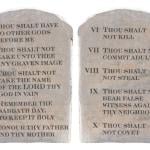Pete Enns reflects today on the problem of violence in the Bible in light of ISIS and the Paris attacks.

He writes,
For me, taking the Bible seriously means looking head on at its persistent themes of mass violence and retribution—whether by God’s hand (e.g., the Flood, Genesis 6), God’s command (e.g., extermination of the Canaanites, Deuteronomy 20), or God’s silent approval (e.g., taking women and children captive as spoils of war, Numbers 31).
For Christians, I believe that condemning mass, ideologically driven, and horrific violence today means taking on the responsibility of deconstructing the violence in the Bible.
That is, Christians should interrogate the depictions of violence and what those depictions mean for us as followers of this faith and as proponents of the Bible’s authority.
He also points, out that while the New Testament differs in kind from the Old Testament in terms of violence, it doesn’t get “a free pass.” The Jesus of the gospels utters some pretty stringent words (“rhetoric of violence”) against the religious leaders who rejected him, and Revelation is of course filled with apocalyptic language with echoes of violence, retribution, and judgment. And so, Enns urges that,
Christians need to look at the book square in the eye and determine whether that rhetoric should be ours and whether this is the most fitting and valid description of God. Christians must wrestle with the very genre of ancient apocalyptic thinking with it’s inherent rhetoric of violence to describe the overthrow of evil, in this case the oppressive Roman Empire.
To sort through the mind-bending horror of ISIS’s terror attacks and to reflect on our response to violence may also require an introspective examination of our own religious text, I’m reminded of a powerful post by Ben Corey, Why Standing Against ISIS Forces You to Rethink Biblical Inerrancy.
For Enns, Christians need to “wrestle” with the violent language of the Bible, which could mean straddling some middle ground between accepting “every line of the Bible as having timelessly equal ultimacy” on the one hand, or seeing “the Bible as more of an ancient relic devoid of spiritual substance and critique” on the other.
In my recent post on the Old Testament and violence, I showed how one author ultimately resolves the problem of OT violence in Christology. The “violent God” of the Bible is outdone by the “loving God” as revealed in Jesus Christ. But Enns rightly reminds us that even the gospel portraits of Jesus Christ and the apocalyptic texts of the New Testament suggest that violence–whether in speech, image, or deed, is never too far removed from the human experience–even the human experience as reflected in our sacred texts.











